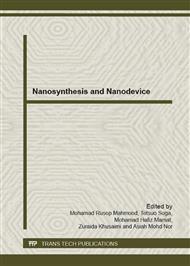[1]
Richard C. Jaeger and Travis N. Blalock, Microelectronic Circuit Design, Mc Graw Hill International Edition, Chapter 4.
Google Scholar
[2]
Robert Chau, Justin Brask, Suman Datta, and Gilbert Duwey, Application of High-k Gate Dielectrics and Metal Gate Electrodes to Enable Silicon and Non-silicon Logic Nanotechnology, Intel Corporation.
DOI: 10.1016/j.mee.2005.04.035
Google Scholar
[3]
Scaling for High Performance CMOS: From SiO2 to High-k, Intel Corporation.
Google Scholar
[4]
Intel Core Microarchitecture, Introducing the 45 nm Next Generation Intel Core Microarchitecture", Intel Corporation.
DOI: 10.1109/hotchips.2007.7482514
Google Scholar
[5]
Jack C. Lee, H.J. Cho, C.S. Kuag, S. Rhee, and Y.H. Kim, High-k Dielectrics and MOSFET Characteristics, IEEE Electron Device Module (2003) 95-98.
Google Scholar
[6]
Matthias Passlack, Ravi Droopad, and Karthik Rajagopalan, High Mobility NMOSFET Structure With High-k Dielectric, IEEE Electron Device Letter 26 (10) (2005) 713-715.
DOI: 10.1109/led.2005.856707
Google Scholar
[7]
Vladimir A. Fonoberov and Alexander A. Balandin, Journal of Nanoelectronics and Optoelectronics 1 (2006) 19-38.
Google Scholar
[8]
Oleg Lupan, Sergiu Shishiyanu, Lee Chow, Teodor Shishiyanu, Thin Solid Films 516 (2008) 3338-3345.
DOI: 10.1016/j.tsf.2007.10.104
Google Scholar
[9]
Haoyong Yin, Zhude Xu, Qingsheng Wang, Jingyi Bai, Huahui Bao, Materials Chemistry and Physics 91 (2005) 130-133.
Google Scholar
[10]
Zhao Guo Liang, Lin Bi Xia, Hong Liang, Meng Xiang Dong, and Fu Zhu Xi, Structural and Luminescent Properties of ZnO Thin Films Deposited by Atmospheric Pressure Chemical Vapour Deposition, ZHOA Guo-Liang et al., Chin. Phys. Lett. Vol. 21, No. 7 (2004).
DOI: 10.1088/0256-307x/21/7/055
Google Scholar
[11]
L.L. Chen, H.P. He, Z.Z. Ye, Y.J. Zeng, J.G. Lu, B.H. Zhao, L.P. Zhu, Influence of post-annealing temperature on properties of ZnO: Li thin films, Chemical Physics Letters 420 (2006) 358-361.
DOI: 10.1016/j.cplett.2005.12.071
Google Scholar


